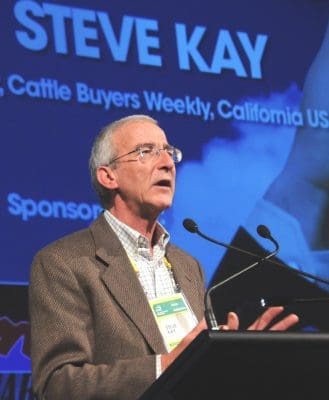 A monthly column written for Beef Central by US meat and livestock industry commentator, Steve Kay – publisher of US Cattle Buyers Weekly
A monthly column written for Beef Central by US meat and livestock industry commentator, Steve Kay – publisher of US Cattle Buyers Weekly
THE worst impacts of the COVID pandemic are behind the US meat processing industry and the country as a whole.
But meat packers still face challenges, notably finding enough workers to fully staff their plants.
As I wrote in my August column, they have faced a labour crisis since the pandemic began last northern hemisphere spring. That crisis has only slightly eased, despite companies’ best efforts to alleviate it.
Packers have tackled the labor shortage on many fronts. They spent hundreds of millions of dollars on multiple ways early in the pandemic to protect their workers, dramatically raised starting wages (to about US$22 per hour) and continue to spend a lot of money on everything from free vaccinations and bonuses for getting the shot to free community college for children of workers.
Federal lawmakers however say packers did not act soon enough to protect their workers, as I discuss later in this column.
Despite the packers’ best efforts, many US beef processing plants are still running well below capacity (10pc or more below), with pork and poultry processing plants having capacity utilisation issues as well.
The reduced capacity is the prime reason why the US grainfed cattle market has struggled all year to gain any real traction in terms of increased prices for fed cattle.
Market leverage over fed beef processors by cattle feeders remains elusive and continues to inhibit a sizeable increase in cash live cattle prices. But they did rise by US$2 per cwt in late October.
As expected, September feedlot marketings were disappointing, especially in regard to the marketing rate (marketings versus cattle on feed numbers). Marketings at 1.789 million head were the third largest September 1 total since 2011. But the marketing rate was below last year at 15.9pc, versus the previous five-year average of 16.1pc.
The year-on-year decline implied that marketings fell 33,000 head short of expectations, says analyst Andrew Gottschalk of HedgersEdge.com. Lower than estimated marketing levels have deferred the timing of the expected seasonal beef price recovery.
It will also likely limit the scope of the recovery. One marketing day was lost in October versus 2020. So it will be a challenge for October marketings to prevent additional carryover into November, he says.
Most analysts had expected the front-end supply of cattle (those on feed 150 days or more) to be below year ago levels on October 1. Instead, it was 8pc higher at an estimated 2.259 million head. This was also 13pc above the 2016-2019 and 2021 five-year average of 2.007 million head.
US COVID-related meat packer deaths
Meanwhile, a startling congressional report released recently said COVID–19 cases and deaths involving US meat plant workers were much higher than previously reported.
Infections and deaths were three times higher than previously estimated, said the House of Representatives Sub-committee on the Coronavirus Crisis. The sub-committee found that 59,000 workers at the five largest meatpackers were infected with COVID. This was almost triple the 22,700 infections previously estimated, based on publicly available information.
At least 269 workers died following contracting COVID, also three times earlier estimates, said the report. The updated numbers come from newly-obtained documents from the five largest US meat packers, JBS USA Holdings, Tyson Foods, Smithfield Foods, Cargill Meat Solutions and National Beef Packing.
Internal information from the companies given to the sub-committee showed early concerns by workers to the pandemic were not addressed by some companies, said the report. Instead of addressing the clear indications that workers were contracting the coronavirus at alarming rates due to conditions in meatpacking facilities, meatpacking companies prioritised profits and product over worker safety, continuing to employ practices that led to crowded facilities in which the virus spread easily, the report said.
The report also alleged that the federal Occupational Safety and Health Administration (OSHA) leadership under the Trump Administration made a political decision to not issue regulatory standards for meatpacking companies that would take specific steps to protect workers. President Trump in April 2020 signed an executive order that labeled meatpacking companies as critical infrastructure.
The companies, with the exception of National Beef, responded to the report by outlining measures they took to limit the spread of the virus. Meat industry trade group the North American Meat Institute (NAMI) also defended the industry’s response at the start of the pandemic.
Front-line meat and poultry workers were among the first impacted by the pandemic, said NAMI president and CEO Julie Anna Potts: But publicly available data confirmed that comprehensive measures implemented in the sector since spring 2020, including extensive infection prevention and vaccination efforts, had successfully protected the sector’s dedicated and diverse workforce as they have continued feeding Americans and keeping the economy working, she said.
Tyson Foods, meanwhile, was close to achieving its goal set on August 3 to vaccinate its entire US workforce for COVID-19 by November 1. Tyson on October 26 said 96pc of its workforce of 160,000 people had been vaccinated for COVID. Getting vaccinated against COVID is the single most effective thing Tyson can do to protect its team members, their families and their communities, said Claudia Coplein, chief medical officer for Tyson Foods.
Tyson remains the only major company in the US meatpacking industry to require vaccinations. The other meat giants have been relying on efforts to encourage workers to get vaccinated.
A boost to Tyson’s effort came from the United Food and Commercial Workers (UFCW). This trade union represents 250,000 meatpacking and food processing workers, including 26,000 Tyson workers, and has expressed its strong support for Tyson’s vaccination efforts. That is partly because at least 132 of its members died from the virus during the outbreaks and another 22,400 of them were infected or exposed.
